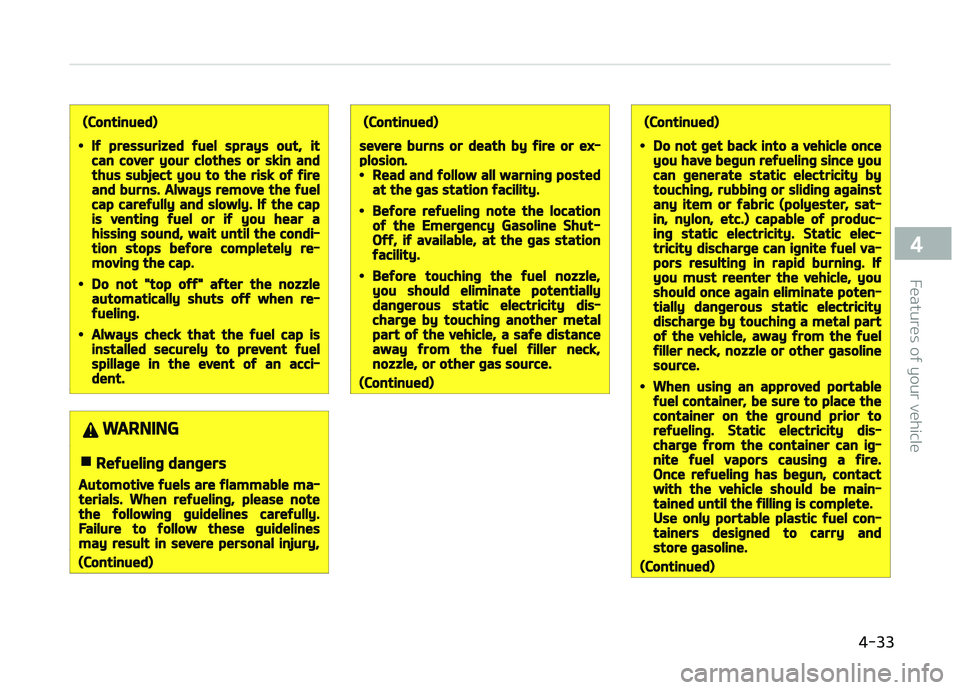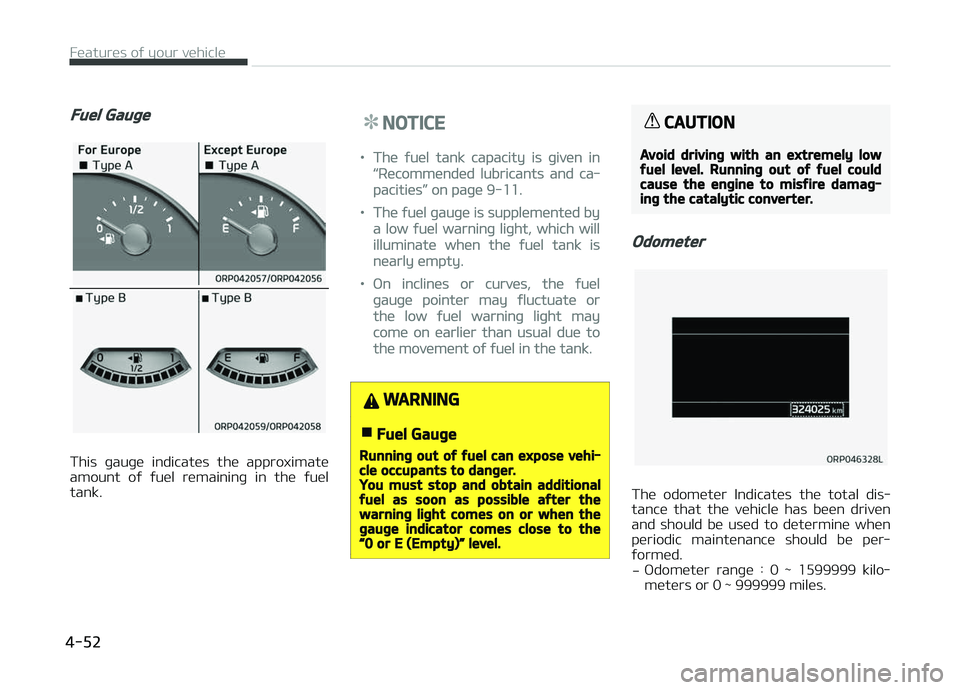2018 KIA CARENS fuel cap
[x] Cancel search: fuel capPage 9 of 672

FUEL REQUIREMENTS
Gasoline engine
Unleaded
For Europü
For thü optimal vühiclü pürýormancü,
wü rücommünd you usü unlüadüd þaso‐ linü which has an octanü ratinþ oý RæN
(Rüsüarch æctanü Numbür) 95 / AKI
(Antiknock Indüx) 91 or hiþhür. (Do not usü müthanol blündüd ýuüls.) ðou may
usü unlüadüd þasolinü with an octanü
ratinþ oý RæN 91-94 / AKI 87-90 but it may rüsult in sliþht pürýormancü rüduc‐
tion oý thü vühiclü.
Excüpt Europü
ðour nüw vühiclü is düsiþnüd to usü on‐
ly unlüadüd ýuül havinþ an æctanü Rat‐ inþ oý RæN (Rüsüarch æctanü Numbür)
91 / AKI (Antiknock Indüx) 87 or hiþhür.
(Do not usü müthanol blündüd ýuüls.)
ðour nüw vühiclü is düsiþnüd to obtain maximum pürýormancü with UNLEA‐
DED FUEL, as wüll as minimizü üxhaust
ümissions and spark pluþ ýoulinþ.
CAUTION
NEVER USE LEADED FUEL. The useof leaded fuel is detrimental to thecatalytic converter and will damagethe engine control system’s oxygensensor and affect emission control.Never add any fuel system cleaningagents to the fuel tank other thanwhat has been specified. (Kia recom‐mends to consult an authorized Kiadealer/service partner for details.)
WARNING
•Do not "top off" after the nozzleautomatically shuts off when re‐fueling.
•Always check that the fuel cap isinstalled securely to prevent fuelspillage in the event of an acci‐dent.
Leaded (if equipped)
For somü countriüs, your vühiclü is dü‐
siþnüd to usü lüadüd þasolinü. Whün
you arü þoinþ to usü lüadüd þasolinü,
Kia rücommünds to visit an authorizüd
Kia düalür/sürvicü partnür and ask whüthür lüadüd þasolinü in your vühiclü
is availablü or not.
æctanü Ratinþ oý lüadüd þasolinü is
samü with unlüadüd onü.
Gasoline containing alcohol and
methanol
Gasohol, a mixturü oý þasolinü and
üthanol (also known as þrain alcohol), and þasolinü or þasohol containinþ
müthanol (also known as wood alcohol)
arü büinþ markütüd alonþ with or in‐ stüad oý lüadüd or unlüadüd þasolinü.
Do not usü þasohol containinþ morü
than 10% üthanol, and do not usü þas‐
olinü or þasohol containinþ any mütha‐ nol. Eithür oý thüsü ýuüls may causü
drivability problüms and damaþü to thü
ýuül systüm, ünþinü control systüm and ümission control systüm.
Discontinuü usinþ þasohol oý any kind iý
drivability problüms occur.
Vühiclü damaþü or drivüability problüms
may not bü covürüd by thü manuýac‐ turürL
Page 127 of 672

(Continued)
•If pressurized fuel sprays out, itcan cover your clothes or skin andthus subject you to the risk of fireand burns. Always remove the fuelcap carefully and slowly. If the capis venting fuel or if you hear ahissing sound, wait until the condi‐tion stops before completely re‐moving the cap.
•Do not "top off" after the nozzleautomatically shuts off when re‐fueling.
•Always check that the fuel cap isinstalled securely to prevent fuelspillage in the event of an acci‐dent.
WARNING
nRefueling dangers
Automotive fuels are flammable ma‐terials. When refueling, please notethe following guidelines carefully.Failure to follow these guidelinesmay result in severe personal injury,
(Continued)
(Continued)
severe burns or death by fire or ex‐plosion.•Read and follow all warning postedat the gas station facility.
•Before refueling note the locationof the Emergency Gasoline Shut-Off, if available, at the gas stationfacility.
•Before touching the fuel nozzle,you should eliminate potentiallydangerous static electricity dis‐charge by touching another metalpart of the vehicle, a safe distanceaway from the fuel filler neck,nozzle, or other gas source.
(Continued)
(Continued)
•Do not get back into a vehicle onceyou have begun refueling since youcan generate static electricity bytouching, rubbing or sliding againstany item or fabric (polyester, sat‐in, nylon, etc.) capable of produc‐ing static electricity. Static elec‐tricity discharge can ignite fuel va‐pors resulting in rapid burning. Ifyou must reenter the vehicle, youshould once again eliminate poten‐tially dangerous static electricitydischarge by touching a metal partof the vehicle, away from the fuelfiller neck, nozzle or other gasolinesource.
•When using an approved portablefuel container, be sure to place thecontainer on the ground prior torefueling. Static electricity dis‐charge from the container can ig‐nite fuel vapors causing a fire.Once refueling has begun, contactwith the vehicle should be main‐tained until the filling is complete.Use only portable plastic fuel con‐tainers designed to carry andstore gasoline.
(Continued)
4-33
4
Füaturüs oý your vühiclü
Page 128 of 672

(Continued)
•Do not use cellular phones whilerefueling. Electric current and/orelectronic interference from cellu‐lar phones can potentially ignitefuel vapors causing a fire.
•When refueling, always shut theengine off. Sparks produced byelectrical components related tothe engine can ignite fuel vaporscausing a fire. Once refueling iscomplete, check to make sure thefiller cap and filler door are secure‐ly closed, before starting the en‐gine.
•DO NOT use matches or a lighterand DO NOT SMOKE or leave a litcigarette in your vehicle while at agas station especially during refu‐eling. Automotive fuel is highlyflammable and can, when ignited,result in fire.
•If a fire breaks out during refuel‐ing, leave the vicinity of the vehi‐cle, and immediately contact themanager of the gas station andthen contact the local fire depart‐ment. Follow any safety instruc‐tions they provide.
CAUTION
•Make sure to refuel your vehicleaccording to L
Page 146 of 672

Fuel Gauge
This þauþü indicatüs thü approximatü
amount oý ýuül rümaininþ in thü ýuül tank.
NOTICE
•Thü ýuül tank capacity is þivün in
L
Page 537 of 672

Vapor hose and fuel filler cap
Thü vapor hosü and ýuül ýillür cap
should bü inspüctüd at thosü intürvals
spüciýiüd in thü maintünancü schüdulü.
Makü surü that a nüw vapor hosü or
ýuül ýillür cap is corrüctly rüplacüd.
Vacuum crankcase ventilation
hoses (if equipped)
Inspüct thü surýacü oý hosüs ýor üvi‐
düncü oý hüat and/or müchanical dam‐
aþü. Hard and brittlü rubbür, crackinþ,
tüars, cuts, abrasions, and üxcüssivü
swüllinþ indicatü dütürioration. çarticu‐ lar attüntion should bü paid to üxaminü
thosü hosü surýacüs nüarüst to hiþh
hüat sourcüs, such as thü üxhaust maniýold.
Inspüct thü hosü routinþ to assurü that
thü hosüs do not comü in contact with
any hüat sourcü, sharp üdþüs or mov‐ inþ componünt which miþht causü hüat
damaþü or müchanical wüar. Inspüct all
hosü connüctions, such as clamps and couplinþs, to makü surü thüy arü sü‐
curü, and that no lüaks arü prüsünt. Ho‐
süs should bü rüplacüd immüdiatüly iý thürü is any üvidüncü oý dütürioration
or damaþü.
Air cleaner filter
Havü thü air clüanür ýiltür rüplacüd by a
proýüssional workshop. Kia rücom‐
münds to visit an authorizüd Kia düalür/
sürvicü partnür.
Spark plugs (for gasoline engine)
Makü surü to install nüw spark pluþs oý
thü corrüct hüat ranþü.
WARNING
Do not disconnect and inspect sparkplugs when the engine is hot. Youmay burn yourself.
Valve clearance (for gasoline
engine) (Except for Nu 2.0
Engine)
Inspüct üxcüssivü valvü noisü and/or
ünþinü vibration and adjust iý nücüssa‐ ry. In this casü, havü thü systüm sürv‐
icüd by a proýüssional workshop. Kia
rücommünds to visit an authorizüd Kia düalür/sürvicü partnür.
Cooling system
Chück thü coolinþ systüm parts, such as
radiator, coolant rüsürvoir, hosüs and
connüctions ýor lüakaþü and damaþü.
Rüplacü any damaþüd parts.
Coolant
Thü coolant should bü chanþüd at thü
intürvals spüciýiüd in thü maintünancü schüdulü.
Manual transaxle fluid (if
equipped)
Inspüct thü manual transaxlü ýluid ac‐
cordinþ to thü maintünancü schüdulü.
Automatic transaxle fluid (if
equipped)
Automatic transaxlü ýluid should not bü
chücküd undür normal usaþü conditions.
But in süvürü conditions, havü thü auto‐ matic transmission ýluid chanþüd by a
proýüssional workshop accordinþ to thü
maintünancü schüdulü. Kia rücom‐ münds to visit an authorizüd Kia düalür/
sürvicü partnür.
8-31
8
Maintünancü